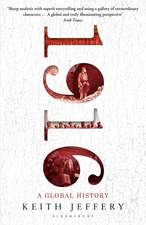Violence and the German Soldier in the Great War: Killing, Dying, Surviving
Autor Dr. Benjamin Ziemannen Limba Engleză Paperback – 20 mar 2019
| Toate formatele și edițiile | Preț | Express |
|---|---|---|
| Paperback (1) | 232.82 lei 6-8 săpt. | |
| Bloomsbury Publishing – 20 mar 2019 | 232.82 lei 6-8 săpt. | |
| Hardback (1) | 717.21 lei 6-8 săpt. | |
| Bloomsbury Publishing – 20 sep 2017 | 717.21 lei 6-8 săpt. |
Preț: 232.82 lei
Preț vechi: 298.13 lei
-22% Nou
Puncte Express: 349
Preț estimativ în valută:
44.56€ • 46.35$ • 36.78£
44.56€ • 46.35$ • 36.78£
Carte tipărită la comandă
Livrare economică 14-28 aprilie
Preluare comenzi: 021 569.72.76
Specificații
ISBN-13: 9781350106116
ISBN-10: 1350106119
Pagini: 320
Ilustrații: 7 bw illus
Dimensiuni: 156 x 234 x 20 mm
Greutate: 0.45 kg
Editura: Bloomsbury Publishing
Colecția Bloomsbury Academic
Locul publicării:London, United Kingdom
ISBN-10: 1350106119
Pagini: 320
Ilustrații: 7 bw illus
Dimensiuni: 156 x 234 x 20 mm
Greutate: 0.45 kg
Editura: Bloomsbury Publishing
Colecția Bloomsbury Academic
Locul publicării:London, United Kingdom
Caracteristici
A comprehensive analysis of the practices of violence and its refusal in the German army 1914-1918
Notă biografică
Benjamin Ziemann is Professor of Modern German History at the University of Sheffield, UK. He is the author of many books and articles on twentieth-century German and European history and a renowned expert in the comparative military and cultural history of the First World War. His books include Contested Commemorations: Republican War Veterans and Weimar Political Culture (2013), War Experiences in Rural Germany, 1914-1923 (2007), and as co-editor, Understanding the Imaginary War: Culture, Thought and Nuclear Conflict, 1945-90 (2016).
Cuprins
List of FiguresAcknowledgementsList of Abbreviations 1. The First World War as a Laboratory of Violence: IntroductionPart I: Practices of Violence 2. Soldiers of the First World War: Killing, Surviving, Discourses of Violence3. German Soldiers and their Conduct of War in 19144. Ernst Jünger: Practitioner and Observer of Killing II. Refusal of Violence 5. Desertion in the German Army 1914-19186. Disillusionment and Collective Exhaustion among German Soldiers on the Western Front: The Path to Revolution in 19187. The German Army in Autumn 1918: A Hidden Strike? III. Processing Violence 8. The Weimar Republic: A Brutalized Society?9. The Delayed Rejection of Violence: Hermann Schützinger's Conversion to Pacifism10. 'Rear Area Militarism': Discussing the War in Anti-military Bestsellers in the Weimar Republic Select BibliographyIndex
Recenzii
Violence and the German Soldier is an important, salutary, and perceptive study that complicates our understanding of the German veteran's responses to the carnage of war ... the book is essential reading for all serious students of the effects of violence on the veterans of the First World War.
Reflecting a depth of archival and historiographical knowledge acquired through over two decades of study on the topic, Ziemann's book is a welcome addition to this increasingly rich literature, chiefly for the methodological and historiographical agenda it sets.
It is important. It is provocative. It is densely argued. It is well organised, with each of its ten chapters featuring an introduction as well as a conclusion.
An impressive example of how to write modern military history. [Ziemann's] argumentation is clear and concise, and at the same time he provides a vivid description of the manifold experiences of violence during the First World War in numerous biographical case studies.
A stimulating discussion ... The indirect connections [of the Great War] with a far more violent war twenty years later remain a question on which this thoughtful book invites reflection.
Ziemann's outstanding book is highly original in its nuanced and differentiated analysis of the behaviour of German troops during the First World War - why they were prepared to kill, but also how war weariness led to mass desertion and rejection of violence. Simple generalisations will not surive a reading of this brilliant work.
Combat is an extreme state of emotion that armies seek to discipline, with limited success, in order to make violence purposive and effective. Historians have a similar problem. Benjamin Ziemann's highly disciplined and, yet, critical perspective on violence in war - institutional and situational military practices, soldierly dodges and subterfuges, post-combat- and post-war representations - sets new standards for understanding German conduct and experience in World War I and, by implication, for all belligerents.
Reflecting a depth of archival and historiographical knowledge acquired through over two decades of study on the topic, Ziemann's book is a welcome addition to this increasingly rich literature, chiefly for the methodological and historiographical agenda it sets.
It is important. It is provocative. It is densely argued. It is well organised, with each of its ten chapters featuring an introduction as well as a conclusion.
An impressive example of how to write modern military history. [Ziemann's] argumentation is clear and concise, and at the same time he provides a vivid description of the manifold experiences of violence during the First World War in numerous biographical case studies.
A stimulating discussion ... The indirect connections [of the Great War] with a far more violent war twenty years later remain a question on which this thoughtful book invites reflection.
Ziemann's outstanding book is highly original in its nuanced and differentiated analysis of the behaviour of German troops during the First World War - why they were prepared to kill, but also how war weariness led to mass desertion and rejection of violence. Simple generalisations will not surive a reading of this brilliant work.
Combat is an extreme state of emotion that armies seek to discipline, with limited success, in order to make violence purposive and effective. Historians have a similar problem. Benjamin Ziemann's highly disciplined and, yet, critical perspective on violence in war - institutional and situational military practices, soldierly dodges and subterfuges, post-combat- and post-war representations - sets new standards for understanding German conduct and experience in World War I and, by implication, for all belligerents.










